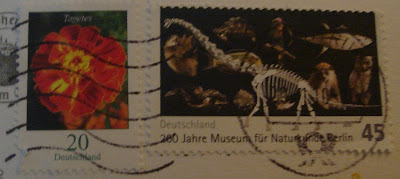Today i've only received one card but it was one of my favorites. I really like it. German castles are so beautiful, this one is great. Viel Danke "usch".


"Hohenzollern Castle is a castle, about 50 kilometers (30 mi) south of Stuttgart, Germany, considered home to the Hohenzollern family that came to power during the Middle Ages and ruled Prussia and Brandenburg until the end of World War I.
The castle is located on top of Mount Hohenzollern at an elevation of 855 meters (2,805 ft), above Hechingen and nearby Bisingen, both located at the foothills of the Swabian Alb. It was originally constructed in the first part of the 11th century. It was completely destroyed after a 10-month siege in 1423 by the imperial cities of Swabia.
A second, larger and sturdier castle was constructed from 1454 to 1461 and served as a refuge for the Swabian Hohenzollern family during wartime, including during the Thirty Years' War. By the end of the 18th century, however, the castle was thought to have lost its strategic importance and gradually fell into disrepair, leading to the demolition of several dilapidated buildings. Today, only the chapel remains from the medieval castle.
The third version of the castle, which stands today, was constructed by King Friedrich Wilhelm IV between 1846 and 1867, under the direction of Oberhofbaurat Stühler, who based his design on English Neo-Gothic style as well as the castles in Loire. Because the castle was built to be merely a family memorial, no member of the Hohenzollern family took residence in this third castle until 1945, when it became home to the last Prussian Crown Prince Wilhelm. Prince Wilhelm and his wife Crown Princess Cecilie are buried there.
Among the historical artifacts of Prussian history contained in the castle today are the Crown of Wilhelm II and some of the personal effects of Frederick the Great and a letter from US President George Washington thanking Baron von Steuben, a scion of the House of Hohenzollern, for his service in the American Revolutionary War. The castle is today a popular tourist destination." - in: wikipedia

 "The Declaration of Independence (1776) and the Constitution of the United States (1787) were both signed in this building in Philadelphia. The universal principles of freedom and democracy set forth in these documents are of fundamental importance to American history and have also had a profound impact on law-makers around the world.
"The Declaration of Independence (1776) and the Constitution of the United States (1787) were both signed in this building in Philadelphia. The universal principles of freedom and democracy set forth in these documents are of fundamental importance to American history and have also had a profound impact on law-makers around the world.
.jpg)
.jpg)

.jpg) "Dundurn Castle is an historic Neoclassical architecture chateau on York Boulevard in Hamilton, Ontario. This 18,000-square-foot (1,700 m
"Dundurn Castle is an historic Neoclassical architecture chateau on York Boulevard in Hamilton, Ontario. This 18,000-square-foot (1,700 m
.jpg) The chain of survey triangulations crosses ten countries, making a total of 34 protected stations points, six of these being located in Finland. One of those points, measured in 1842, is located in the church tower of Alatornio (Tornea). Carved markings made in connection with the measurements are still visible on the walls of the bell chamber of the church, which was built in 1797. The top of the bell tower is 40 metres above sea level, which made it an ideal location for triangulation. It is still part of the station-point network of the City of Tornio.
The chain of survey triangulations crosses ten countries, making a total of 34 protected stations points, six of these being located in Finland. One of those points, measured in 1842, is located in the church tower of Alatornio (Tornea). Carved markings made in connection with the measurements are still visible on the walls of the bell chamber of the church, which was built in 1797. The top of the bell tower is 40 metres above sea level, which made it an ideal location for triangulation. It is still part of the station-point network of the City of Tornio.


.jpg) The Golden Gate of Vladimir was built between 1158 and 1164, are the only (albeit partially) preserved instance of the ancient Russian city gates. A museum inside focuses on the history of the Mongol invasion of Russia in the 13th century.
The Golden Gate of Vladimir was built between 1158 and 1164, are the only (albeit partially) preserved instance of the ancient Russian city gates. A museum inside focuses on the history of the Mongol invasion of Russia in the 13th century. .jpg)
.jpg) A card from Poznan sent by Joanna "redka".
A card from Poznan sent by Joanna "redka"..jpg)
.jpg) A beautiful card from Amsterdam sent by Sandra "mya".
A beautiful card from Amsterdam sent by Sandra "mya".


.jpg)

 PT-107823, sent by Nuno.
PT-107823, sent by Nuno.
 GB-114895, sent by Anu "ichabodhides".
GB-114895, sent by Anu "ichabodhides".

.jpg)


.jpg)

.jpg)


.jpg)

 RU-66270, sent by Daryana.
RU-66270, sent by Daryana.
 RU-62268, also sent by Daryana.
RU-62268, also sent by Daryana.